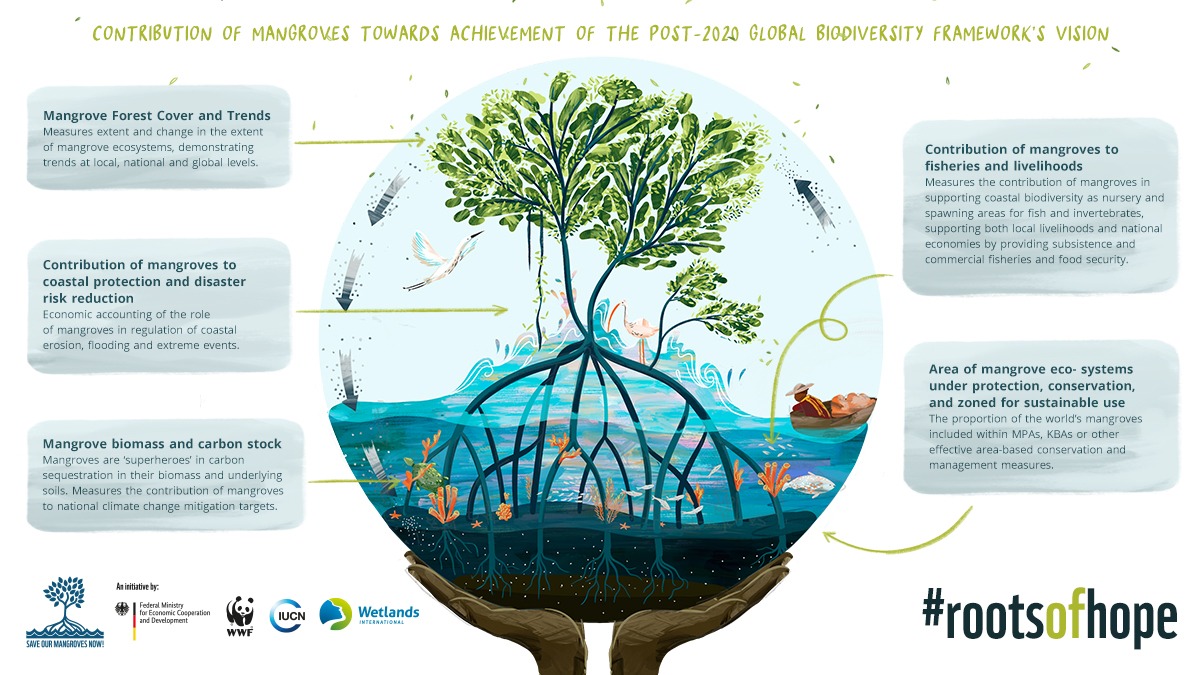Roots of Hope
How mangroves contribute to living in harmony with nature by 2050
At the UN Biodiversity Summit in December 2022, governments are preparing to adopt a new global framework for managing nature through 2030. It will guide actions worldwide to preserve and protect nature and its essential services to people en-route to living in harmony with nature by 2050.
In response, the global mangrove expert community presents a detailed guidance to illustrate how mangrove ecosystems contribute towards the achievement of multiple goals, targets and associated indicators so that “by 2050, biodiversity is valued, conserved, restored and wisely used, maintaining ecosystem services, sustaining a healthy planet and delivering benefits essential for all people”.

“Mangroves are superheroes, a triple dividend of resilience, biodiversity gain and people”,
says Minna Epps, Director of IUCN’s Global Marine and Polar Programme.
“Protecting and conserving them is essential for achieving multiple goals and targets towards the 2050 vision for biodiversity. They are our roots of hope – it is time that their importance is widely recognized.”
The conservation of mangroves constitutes a coastal nature-based solution for the biggest challenges humanity face today. They play a crucial role in combating climate change by storing 3 to 5 times more carbon than terrestrial forests. They provide habitat for over 3000 fish species and other wildlife, thus providing livelihoods to more than 120 million people, generating income and food security. They protect coastal areas by reducing wave height by up to 66%. If mangroves were lost, 15 million more people would experience annual flooding across the world.
Achieving the ambitious 2050 vision will take a joint effort by all Parties. The “Guidance on Mangrove Indicators in the Post-2020 Global Biodiversity Framework” provides a detailed collection of scientifically robust data and resources for consideration by governments in support of their national reporting and progress tracking against the goals, targets and indicators set in the post-2020 Global Biodiversity Framework.
The guidance is intended to contribute to the ongoing discussions convened by the UN Convention on Biological Diversity (CBD) towards the adoption of the Biodiversity Framework.
”This is urgently needed”,
states Julika Tribukait, Policy Advisor on Coastal Ecosystems at WWF Germany,
“to allow for mangroves and other coastal ecosystems to be taken fully into account in the development of and future reporting against the post-2020 Global Biodiversity Framework.”
The guidance was prepared by experts from Save our Mangroves Now!—a joint initiative by WWF, International Union for Conservation of Nature (IUCN), Wetlands International, and the German Federal Ministry of Economic Cooperation and Development (BMZ)—as well as the Global Mangrove Alliance, the Global Mangrove Watch, and the IUCN Mangrove Specialist Group.
You can find the full Guidance here.